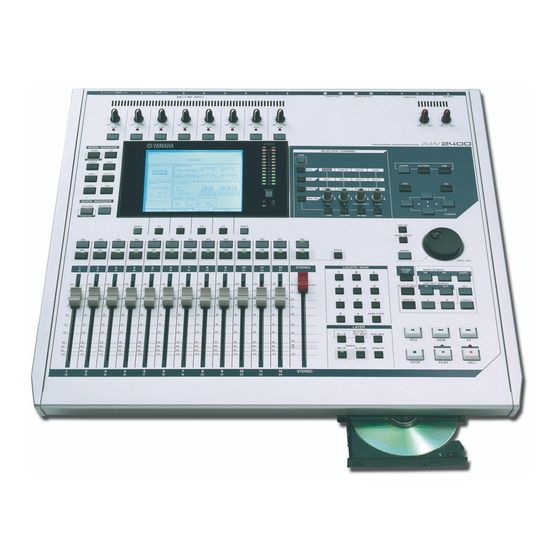Yamaha AW2400 Podręcznik - Strona 21
Przeglądaj online lub pobierz pdf Podręcznik dla Instrument muzyczny Yamaha AW2400. Yamaha AW2400 30 stron. Professional audio workstation
Również dla Yamaha AW2400: Broszura i specyfikacje (6 strony)

according to how you would actually hear them if you were facing a
set of drums. For example, the low tom would be panned to the left
while the hi-hat would be panned a little to the right.
Bass:
This is almost always panned straight up the center.
Guitars:
Rhythm guitars are usually panned to either the 9 o'clock position
or the 3 o'clock position. You can try panning them a little farther
out or closer in depending upon the other instruments in the mix.
Guitar solos are usually panned either straight up the center or just
a little off to one side or the other so they won't conflict with the
vocals.
Keyboards: If the keyboard is a stereo patch then you would pan one side all of
the way to the left and the other side all of the way to the right. If it
is a mono patch you would usually pan it opposite of any rhythm
guitars you may have.
Vocals:
The lead vocals are almost always panned straight up the center. If
the background vocal is just a double of the lead vocal or is a single
harmony then it would usually be panned up the center also. If
there are multiple background vocals they would normally be
panned just a little off center to the left and the right. For a wider
sound you may prefer to pan some of the background vocals all of
the way to the left and the rest all of the way to the right.
Percussion: If the percussion is a very important part it would be panned just a
little to the left or to the right of center. If it is a small part that only
occurs a few times throughout the song you may want to pan it
either all of the way to the left or right.
The idea is to create space for each individual instrument. The
instruments that you want to be the focus of attention would be panned in the
center and then supporting instruments would be panned off the sides.
Adjusting the EQ
The next step in the mixdown process would be to adjust the EQ of any
tracks that need it. It is very easy to over EQ and ruin a good mix so listen to the
tracks first and then, if EQ is needed, use it sparingly. When using EQ, It's
always better to use subtractive EQ rather than additive EQ. Subtractive EQ
means to take away frequencies. Additive EQ means to boost frequencies.
Anytime you add EQ, noise is also added. If you take away the offending
frequencies instead off adding EQ you will have a cleaner mix.
18
